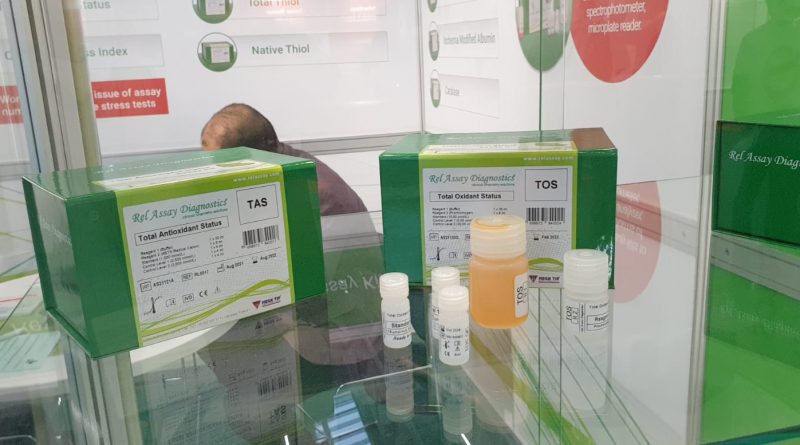Total Antioxidant Status (TAS)
Abstract
A growing number of studies reveal that oxidative stress is associated with viral infections or the development of cancer. However, there are few reports evaluating the relationships between oxidative stress, viral infection and carcinogenesis. The present study analyzed the level of total antioxidant status (TAS), as well as the activities of glutathione peroxidase (GPx) and superoxide dismutase (SOD) in patients with oropharyngeal cancer, both with Epstein-Barr virus (EBV) positive as with EBV negative. comparison with the control group. Correlations between these parameters and EBV type (wild-type LMP1 (wt-LMP1) or deleted LMP1 (del-LMP1)), EBV antibody level, degree of tumour differentiation, and tumour classification were also investigated. NMT. Fresh frozen tumour tissue samples collected from 66 oropharyngeal squamous cell carcinoma patients were analyzed by nested PCR assay for EBV DNA detection.
Spectrophotometric methods were used to measure TAS values, as well as SOD and GPx activities in tissue homogenates, using diagnostic kits produced by Randox Laboratories. The sera of all individuals were investigated by the ELISA method to detect the presence of Epstein-Barr virus capsid antigen (EBVCA) IgM and IgG, Epstein-Barr virus nuclear antigen (EBNA) IgG and IgG antibodies. early antigen (EA). TAS level and antioxidant enzyme activities (GPx and SOD) were significantly reduced in oropharyngeal cancer tissues, particularly in EBV-positive cases. In 82.3% of patients, wt-LMP1 was detected. Significantly lower values of TAS, GPx and SOD were established in patients infected with wild-type EBV.
The presence of antibodies against the early antigen (anti-EA) was detected in more than 80% of the patients, suggesting reactivation of the EBV infection. The correlation between the degree of tumour differentiation and the TN classification was also observed, especially in EBV-positive patients. Determination of these parameters may be useful to assess tumour burden in patients with various stages of oropharyngeal cancer and could be an important prognostic factor. Future studies are needed to understand the role of oxidative stress-induced EBV lytic reactivation.
Properties
Use: enough for 100 colourimetric tests
Detection method: colourimetric
Storage temperature: 2-8°C
General description
Oxidants, such as reactive oxygen species (ROS) and reactive nitrogen species (RNS), can generate free radicals that can cause severe oxidative damage to cell lipids, membranes, proteins, and DNA. Antioxidants can eliminate these free radicals and prevent cellular oxidative stress through enzymatic and non-enzymatic mechanisms. Enzyme systems that function as antioxidants include catalase and peroxidase. Tocopherols, carotenoids, vitamin A, and ubiquinols function as fat-soluble antioxidants; while glutathione and ascorbate are some of the water-soluble antioxidants. Measurement of the total non-enzymatic antioxidant capacity (TAC) of biological samples is indicative of their ability to counteract oxidative stress-induced damage to cells. TAC is used to provide information on the development and treatment of disorders related to oxidative stress.
In the Total Antioxidant Capacity Assay Kit, the concentration of the combination of small molecule antioxidants and protein, or the concentration of small molecule antioxidants alone, can be determined. The Cu2+ ion is converted to Cu+ by both small molecules and proteins. However, the use of Protein Mask prevents the reduction of Cu2+ by the protein, allowing the analysis of only small molecule antioxidants. The reduced Cu+ ion was chelated with a colourimetric probe, giving a broad absorbance peak at ~570 nm, which is proportional to the total antioxidant capacity. The kit provides antioxidant capacity in Trolox equivalents (between 4 and 20 nmol/well). Trolox, a water-soluble vitamin E analogue, serves as the antioxidant standard.
Request
The Total Antioxidant Capacity Assay Kit has been used to determine the total antioxidant capacity of leaf tissue samples.
Suitability
This kit is suitable for the detection of small molecules and antioxidant proteins in cell and tissue lysates, media, or biological fluids such as urine, plasma, and serum.
Beginning
In the Total Antioxidant Capacity Assay Kit, the concentration of the combination of small molecule antioxidants and protein, or the concentration of small molecule antioxidants alone, can be determined. The Cu2+ ion is converted to Cu+ by both small molecules and proteins. However, the use of Protein Mask prevents the reduction of Cu2+ by the protein, allowing the analysis of only small molecule antioxidants.
The reduced Cu+ ion was chelated with a colourimetric probe, giving a broad absorbance peak at ~570 nm, which is proportional to the total antioxidant capacity. The kit provides antioxidant capacity in Trolox equivalents (between 4 and 20 nmol/well). Trolox, a water-soluble vitamin E analogue, serves as the antioxidant standard.

